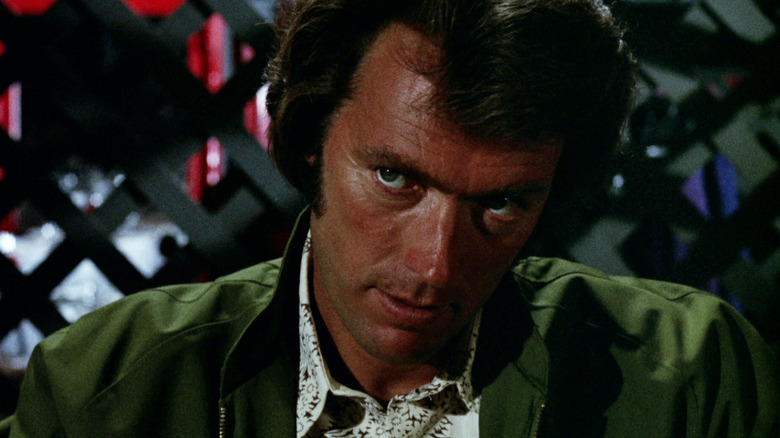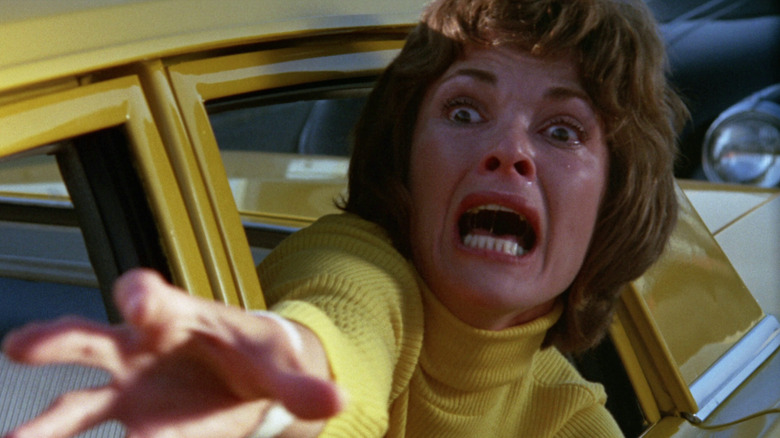Clint Eastwood's Directorial Debut Had To Follow One Condition From The Studio
It is a cliché by this point that once a movie star achieves a certain degree of success, they begin telling everyone that what they'd really like to do is direct. Sometimes it works out. Kevin Costner won Best Picture and Best Director for his 1990 feature debut with "Dances with Wolves," and then you've got Charles Laughton, whose only directorial effort, "Night of the Hunter," is considered one of the greatest movies ever made. On the other end of the spectrum, there's Dan Aykroyd and the inexplicable horror-comedy debacle that is "Nothing But Trouble" (once titled "Valkenvania"). This was a passion project for Aykroyd (he wrote and directed it), and he's only now beginning to make sense of its wreckage (most recently via a wide-ranging Q&A quoted at Stereogum).
Directing can be a collaborative process, or it can be an act of control. And some actors don't like ceding control to the director (and producer[s] and editor), basically leaving the quality of their performance in the hands of others — particularly if they often found themselves at odds with some of these people during the shoot. Could they truly trust these folks if they hadn't seen eye-to-eye on their performance while they shot it?
But not all stars seek the director's chair for the promise of prominence. Sometimes, the only way you can get a commercially risky movie into production is to tell the studio that you'll take on the main character, which, in some cases, means playing aggressively against type. This kind of image-shredding bravery is the only reason Clint Eastwood gave us masterpieces like "Unforgiven," "A Perfect World," and "The Bridges of Madison County." And none of these classics would've been possible had he not agreed to star in "Play Misty for Me."
Universal wouldn't allow Clint Eastwood to direct Play Misty for Me unless he starred in it
In a 2003 appearance on Michael Parkinson's BBC talk show to promote "Mystic River," Eastwood revealed that the only way he could get his first directorial effort, "Play Misty for Me," made was to promise Universal Studios that he would star in the film as well. Eastwood had successfully segued from the Italian-produced Spaghetti Westerns that launched his Hollywood movie career by this point, but he'd done so by leaning on his tough, laconic iconography. "Play Misty for Me" was a thriller about a Bay Area jazz disc jockey whose womanizing ways put his life at risk when one of his listeners (the great Jessica Walter) becomes dangerously obsessed with him. This was not wheelhouse material for Eastwood, the actor.
As we'd learn throughout his career, Eastwood wasn't precious about his persona. He played a sexually adventurous detective in the disturbing "Tightrope, a cop with a bad ticker in "Blood Work," and a horticulturist-turned-drug-mule in "The Mule." Obviously, the legendary actor and filmmaker did nothing to harm his movie star stature; the film was a huge box office hit that proved audiences could square a more vulnerable Eastwood with his portrayal of the due-process flouting titular cop in "Dirty Harry" (which opened three months later to monster business).
Eastwood felt that if he could get a couple of hits under his belt as a director, he'd be free to make films where he stayed behind the camera. After his second directorial effort, "High Plains Drifter" delivered at the box office, he directed William Holden and Kay Lenz in "Breezy," in which he only made an uncredited cameo. But it wasn't until the 21st century that, having entered his 70s, Eastwood seriously dialed back on acting. He turned 95 this year and has made noise about stepping back behind the camera. Given that his last movie as a director, "Juror #2," was a terrific courtroom thriller, let's get our Clint back to work!

